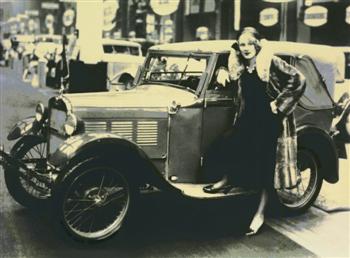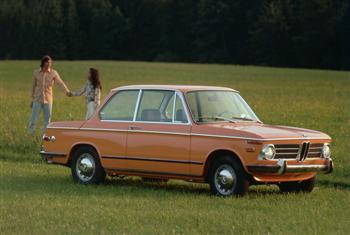|
Home | News | Road Tests | ||||||||||||
BMW: 80 years of car production
Guests invited to BMW’s new showroom in the middle of Berlin in July 1929 were able to admire a small car bearing the model designation 3/15 PS DA 2, with the two last letters standing for “Deutsche Ausführung” or “German Version”. The car soon took on a new name, BMW’s first production model remaining a legend to this day as the “Dixi”. The first of these small performers coming off the production line on 22nd March 1929 in BMW’s plant near the former Berlin-Johannisthal Airport set the foundation not only for the production of cars by BMW. For although the Dixi was largely taken over from an existing model with parts and components already in use, the car clearly bore the handwriting typical of BMW to this very day: From the beginning efficiency and dynamics were of utmost significance to BMW, forming an integral part of the brand’s 'DNA'. Indeed, BMW had already made a great name for itself as a manufacturer of very economical high-performance products such as aircraft engines and motorcycles, before entering car production. Before BMW fitted the brand’s white-and-blue logo on the radiator grille of the Dixi, the car had already been updated in technical terms and, as its highlight, boasted a new all-steel body. As a result the BMW 3/15, very modern at its time, won the International Alpine Rally in its very first attempt in 1929, successfully completing all large passes in the Alps during the race lasting a full five days. Apart from its reliability, the Dixi also appealed to a growing number of customers through its all-round economy and relatively low price: Consuming just six litres of regular fuel, the Dixi was more economical right from the start than rail transport and the customer had the option to pay the purchase price of 2,200.– reichsmarks for the “base” version in instalments, if they wished to do so. This made the BMW a lot cheaper than a comparable Hanomag, with the car coming at about the same price as the best seller back then, the Opel Laubfrosch. Early type of VANOS technology back in 1938. Step-by-step BMW’s engineers developed technologies and concepts in the years to come to improve both efficiency and driving dynamics, thus building up a significant lead over their competitors. Even back in the 1930s, for example, BMW looked into variable camshaft management and took out the first patent for this technology in 1938/39. Several prototypes of the BMW 802 aircraft engine already featured a technology which today, naturally enhanced to a higher level, serves to offer greater efficiency in all of BMW’s petrol engines in the guise of double-VANOS. On BMW’s 2,500-horsepower aircraft engine, the intake and exhaust valves were masterminded by cam discs adjustable to various settings while the engine was running. In 1940 BMW introduced a further international highlight in one of the main areas of Efficient Dynamics: light weight construction. The BMW 328 Kamm Racing Coupé is indeed a particularly outstanding example of the supreme performance of the BMW 328 in motor sport. The car’s tubular space-frame was made of an extra-light electron alloy and weighed just 32 kg. Together with the outer skin made of aluminium and the six-cylinder power unit, unladen weight was a low 760 kg. Superior aerodynamics instigated by Wunibald Kamm, one of the pioneers of modern streamlining, gave the car a drag coefficient of approximately 0.27. This, together with 136 horsepower coming from the two-litre engine, provided a top speed of 230 km/h. BMW took up this concept again after the war, following the same philosophy in 1961 in the BMW 700 RS. This new racing car bearing the white-and-blue emblem excelled through its extremely light structure, again featuring an elaborate tubular space-frame combined with light aluminium outer 'skin'. In road trim this small racer weighed a mere 630 kg, no problem at all for the racing engine specially developed for this little car: The 70-hp two-cylinder displaced just 0.7 litres, giving the engine an output per litre of 100 horsepower still quite remarkable today and accelerating the RS to 160 km/h. Particularly with the great German racing driver Hans Stuck at the wheel back then, the BMW 700 RS scored numerous wins in all kinds of hill climb events. 1968: BMW six-cylinders once again setting the standard for years to come. Following the outstanding success of BMW’s New Range and the 02-models, BMW was able in 1968 to once again take up the great tradition of the 1930s with larger six-cylinder power units. So this marked the debut of the BMW 2500 and 2800 taking the company back into the market for large saloons and coupés. The engines themselves were the same in both body variants: Fitted at an angle of 30°, the power units came with a crankshaft running in no less than seven earings and incorporating twelve counterweights for vibration-free smoothness further enhanced by the overhead camshaft. This, clearly, led to the concept of turbine-like smoothness on BMW’s six-cylinder power units. One of the technical innovations on the two engines identical in their structural features was the triple-hemispherical swirl-action combustion chamber interacting with appropriately designed pistons. This particular configuration ensured an even more intense fuel/air combustion process serving in this case to provide superior power on good fuel economy: The 2.5-litre delivered maximum output of 150 hp, the 2.8-litre an even more impressive 170 hp – sufficient to boost the BMW 2800 into the exclusive group of 200 km/h cars. And achieving a top speed of 190 km/h, the BMW 2500 likewise had only a few competitors to fear. No surprise, therefore, that BMW’s six cylinders set a standard in modern engine technology for years to come. A big contribution to this supremacy came from a racing car representing the sporting extreme of Efficient Dynamics at the time: the BMW 3.0 CSL built in 1971. Once again, intelligent light weight engineering served to make this model even more dynamic, with sophisticated aerodynamics helping to optimise the car’s driving characteristics. As an example, BMW introduced features at the time such as specially developed downforce flaps and a complete underfloor cover. Qualities of this kind made these light, powerful and fast coupés unbeatable for many years, with BMW winning all but one European Touring Car Championships between 1973 and 1979. 1972: the BMW electric car makes its first appearance. In the early ’70s BMW’s development experts focused very carefully not just on outstanding achievements in motor sport. Rather, in 1972 the starting point for intense research was on electric drive technology, a small fleet of orange-coloured BMW 1602 Saloons boasting battery-powered electric motors were put on the road. Just a year later BMW introduced another pioneering model featuring highlights in technology now once again gaining greater significance: The BMW 2002 turbo was the first production car in Europe to feature a turbocharged engine. This gave BMW a leading role in turbo technology, at the same time setting the foundation for the successful use of this technology in both series production and motor sport. BMW’s next step in efficient technology came in 1978, the BMW M1 super sports car with its four-valve technology carried over from motor sport setting a new benchmark in optimising the cylinder charge process. BMW started using this technology successfully in motor sport in the late 1960s, developing it to production standard ten years later, with optimised cylinder charge technology being subsequently used in other BMW M models such as the M635CSi, the M5 and the M3. In 1979 the first Digital Motor Electronics in the BMW 732i set new standards throughout Europe, map control helping to provide more power on less fuel. This improvement was further enhanced by automatic overrun cut-off reducing fuel consumption to zero in the overrun mode. All this set another milestone in the market, BMW becoming the pioneer in automotive electronics. In the process of enhancing motoring efficiency, BMW never lost sight of the driver and his/her particular role. Precisely this was the reason for the introduction of the world’s first fuel consumption gauge in the BMW 5 Series as yet another achievement in electronics in 1981. This new display sensitised the driver to the issue of fuel economy, showing him clearly how he/she was able to drive more economically, that is on less fuel. And to this day, the fuel consumption indicator plays an important role in the context of BMW’s Efficient Dynamics strategy. The BMW 524td: a milestone in diesel technology. The decision taken by BMW to enter the fiercely contested diesel car market was revolutionary in the history of the company, a new generation of engines marking this significant breakthrough. The BMW 524td introduced in June 1983 featured a diesel engine combining the benefits of diesel technology with qualities typical of BMW such as dynamic performance and refinement. And this led straight to the development of BMW’s turbodiesel based on the existing range of straight-six power units between 2.0 and 2.7 litres engine capacity. Using turbocharger technology and large flow cross-sections on the intake and outlet valves of the 2.4-litre power unit, BMW’s engineers were able to increase engine power to 115 hp. At the same time the swirl-chamber combustion process enhanced to an even higher standard provided an ideal basis for minimising both fuel consumption and combustion noise: Under the DIN standard, this modern BMW turbodiesel made do with just 7.1 litres/100 km, despite the car’s top speed of 180 km/h and acceleration to 100 km/h in 12.9 seconds, setting new standards at the time in the dynamic performance of diesel cars. A truly unique concept: the eta engine. Yet another new concept introduced by BMW, this time in the 'petrol' market, was BMW’s eta technology available from late 1981 in the BMW 528e sold in the US market. In the northern spring of 1983 this initial model was followed by the BMW 525e in Germany before the BMW 325e was launched in Europe in 1985. The letter “e” stood for eta, the symbol for efficiency. And indeed, the 2.7-litre six-cylinder power unit featured in this very special model was optimised without compromises for superior torque and economy, consuming just 8.4 litres of regular grade fuel on 100 kilometres, despite engine output of 122 hp. Back then this kind of fuel economy on a large six-cylinder (with virtually the same fuel consumption under practical driving conditions) was acknowledged as truly sensational. The concept of a large power unit with relatively low power was indeed quite unusual back then in Europe and remains exceptional to this day. It was also in the early ’80s that BMW started developing the hydrogen car, taking on a role in the development of the hydrogen combustion engine and, together with the German Research and Test Institute for Aerospace Technology, building several test models as of 1984. One of these cars was the BMW 745i Hydrogen. BMW consistently maintained this development process, building hydrogenpowered experimental versions of the BMW 7 Series in all upcoming generations of the car and in each case pushing this technology to its extreme limit. In the process BMW succeeded in combining the hydrogen combustion engine with both environmental compatibility and sporting performance. The further reduction of driving resistance was one of the highlights in developing two BMW sports cars in the late 1980s: The first of these models was the BMW Z1, a genuine spearhead in innovation and technology, launched in 1988 and boasting not only very low weight thanks to its body shell made of a special synthetic material, but also a drag coefficient of 0.36. This progress in aerodynamics was attributable, among other things, to the fully covered underfloor with a diffuser at the rear, while the driver and passenger enjoyed optimum driving conditions with draughts reduced to a minimum. The other example was the BMW 850i Coupé introduced a year later, again setting new standards in aerodynamics. Despite its large cooling air intakes for the twelve-cylinder power unit, this elegant coupé came with a drag coefficient of just 0.29. Again, this was because very many of the car’s aerodynamic components such as the exterior mirrors with hardly any effect on air drag had been developed very carefully in a painstaking streamlining process. In 1991 BMW took up the concept of the electric car once again, demonstrating the current (huh) state of the art in the BMW E1. This first all-electric car built in recent times worldwide was a fully-fledged car offering space for four passengers and their luggage. Made consistently in light weight construction, the body was a combination of extrusion-pressed aluminium profiles with the outer panels made of plastic and aluminium. The objective in developing this very special car was to build a genuine BMW with unrestricted driving pleasure – and precisely this was the objective BMW achieved so impressively. Given cars and technologies of this standard, the development of alternative drive systems by BMW was just as innovative and dynamic as the development of conventional power units. In 1992 BMW introduced infinitely variable valve management – BMW VANOS – as a world-first achievement in the M3 sports car, improving both power and torque as well as fuel economy and the management of emissions. As of 1992 VANOS was also featured as a further improvement on BMW’s other six-cylinder power units, being replaced as of 1995 by double-VANOS which as of 1998 was alsointroduced on BMW’s V8 engines.
1995: BMW 5 Series takes on lightweight construction. In 1995 the next generation of the BMW 5 Series entered the market with light weight construction. This was BMW’s first large-scale production car to feature a chassis and suspension made completely of light alloy and reducing the weight of the entire vehicle by approximately 30 per cent. The all-aluminium power units were also 30 kg than before, helping to reduce unladen weight of the BMW 523i, for example, from 1,525 kg to 1,495 kg. In the same year BMW introduced the 316 g and 518 g, Europe’s first natural gas cars to enter series production. This alternative drive technology served to reduce CO2 emissions by approximately 20 per cent and the formation of ozone-building hydrocarbons (HC) by an even more significant 80 per cent. At the same time the new engines made a further contribution to the series development of hydrogen drive, since natural gas comes with very similar features and qualities relevant to the car. In all, BMW built a small series of 842 natural gas-powered models up to the year 2000. Moving on to the year 2001, BMW enhanced the VANOS technology into fully variable VALVETRONIC valve management running the engine for the first time without a throttle butterfly and remaining absolutely unique the world over to this day. In the four-cylinder power unit of the BMW 316ti this meant more performance on less fuel, particularly under part load, thus reducing fuel consumption versus the former model by a most significant 12 per cent. One of the big advantages of this technology is that it can be used worldwide, since it does not make any particular demands in terms of fuel quality. | ||||||||||||
More BMW News .....
here
About | Car Clubs | Home | News | Road Ramblings | Road Tests | Subscribe | Top Drive © 2009 All rights reserved. Next Car Pty. Ltd. |





